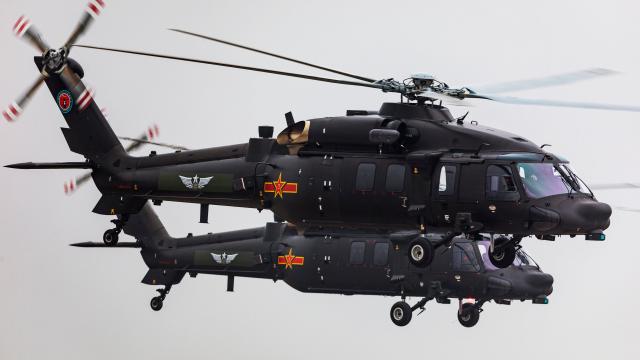China’s 70th Anniversary parade, held earlier this month in Beijing, included the debut of one of the People’s Liberation Army’s worst-kept secrets: the Harbin Z-20 helicopter. The Z-20 medium helicopter, dubbed “Copyhawk” by Western observers, is a familiar sight because it’s a copy of the American UH-60 Blackhawk helicopter. Still, the Blackhawk helicopter design is more than forty years ago and the U.S. military is forging ahead with a new generation of assault helicopters — some of which are technically not even helicopters.
In the late 1980s, as the Cold War wound down, Western defence contractors courted the People’s Republic of China as the next great arms market. China, its economy at the start of an incredible, three decade long growth spurt, purchased scads of military tech from U.S. and European defence contractors. This included tank guns for the People’s Liberation Army Ground Forces, surface-to-air missiles for the Navy, and helicopters for the People’s Liberation Army Air Force.
In 1984 China purchased 24 Sikorsky S-70C-2 helicopters, the civilian version of the UH-60 Blackhawk. The helicopters went straight into People’s Liberation Army service. In 2008 the helicopters were photographed in Sichuan province, providing disaster relief services in the aftermath of a devastating earthquake that killed 87,000 people.
China probably would have purchased a lot more Blackhawks were it not for the 1989 Tiananmen Square massacre, when the Chinese Communist Party sent the PLA into Beijing to disperse pro-democracy protests. Thousands of protesters were killed, shot down in the street and even run down by armoured personnel carriers. The West, including the United States, slapped an arms embargo on China that is still in effect today.
Suddenly shut-out of the latest technology, China started cloning the equipment it had already purchased. China reportedly tried to copy the S-70 as early as the 1990s but lacked the ability to build high performance turboshaft engines. The program reportedly gathered steam in the 2010s, with occasional sightings of what became known as the Z-20 helicopter. The helicopters were finally unveiled to the public on October 1, 2019, during the 70th Anniversary parade.
The Z-20 was developed by the Harbin Aircraft Industry Group under the state-run Aviation Industry Corporation of China (AVIC), which describes it as an “advanced level 21st century aircraft”. The Z-20 is an all-weather helicopter that can carry out, “personnel and cargo transport, search and rescue, reconnaissance and anti-submarine operations”.
Another interesting comparison of the Z-20 vs the original Blackhawk.
(Image via @彩虹熊_白玮 from Weibo) pic.twitter.com/nyP3zmSyiY
— @Rupprecht_A (@RupprechtDeino) October 11, 2019
The Z-20 is clearly descended — or at least heavily inspired — by the S-70/UH-60. The helicopters have the same general layout, same high visibility cockpit, engine placement, and tail arrangement. Both have permanently affixed landing gear. The main outward difference between the two is the use of a four bladed main rotor by the UH-60 and a five bladed rotor by the Z-20.
Internally the Z-20 features an interesting detail: according to AVIC, it features a fly-by-wire flight control system. Fly by wire, introduced in fighter planes in the 1970s, uses onboard computers to interpret a pilot’s commands, constantly making subtle changes in the aeroplane’s flight characteristics. Li Linhua, chief technology expert at AVIC’s China Helicopter Research and Development Institute, told Chinese state media, “The adoption of (fly by wire technology) substantially reduces the Z-20’s overall weight and makes it easier to fly.” The use of fly by wire technology could have made up for China’s deficiency in helicopter engine technology, compensating for a less powerful WZ-10 engine.
China’s Harbin Z-20 land-based and Z-20F naval helicopters. The resemblance to Sikorsky’s Blackhawk and Seahawk design is clear pic.twitter.com/cxTN5HT8wo
— Mike Yeo 杨启铭 (@TheBaseLeg) October 14, 2019
Like the Blackhawk, the Z-20 is apparently also fated to go to sea. A naval version, the Z-20F, was spotted with a light grey paint job — very different from the PLA’s matte black helicopters. The Z-20F will, as Defence News points out, likely become the Chinese Navy’s main anti-submarine warfare helicopter, replacing the smaller, lighter Z-9 (itself based on the Eurocopter Dauphin.)
Meanwhile back in the land of the Blackhawk, the U.S. Army is studying a series of possible replacements under the Future Long Range Assault Aircraft (FLRAA) program. FLRAA, due to enter service in 2030, is the Army’s first new medium size transport aircraft in decades and the service is pushing defence contractors to come up with something radically new.
Lockheed Martin’s Defiant platform uses contra-rotating main rotors with a push propeller in the rear. Bell’s V-280 Valor looks like a cross between the Blackhawk and the V-22 Osprey, using tilting engines instead of a tilting wing assembly. The Army wants FLRAA to cruise at up to 280 knots, much faster than the UH-60’s 193 knots.
China may have finally perfected the Copyhawk, but in many ways it’s a generation behind other aircraft programs. It would not at all be surprising if China is already working on its own answer to the U.S. Army’s FLRAA. China fully intends to catch up to the U.S. in all areas of defence technology, a goal that seems more likely with each passing day.
